happy days
YOU CANNOT KILL THE
SHADOW

the art of
GUDRUN VERA HJARTARDOTTIR
______________
A
solo exhibition at Broadway Gallery in Soho, NY, reviewed by
TAMARA SCHILLIN
Gudrun
Vera Hjartardottir, born in 1966 in Reykjavik, Iceland currently
lives in Kopavogur and works in Reykjavik. A graduate of the
Icelandic College of Art and Crafts and the Reykjavik School
of Visual Arts, Gudrun Vera is the recipient of numerous visual
arts grants and prizes. She has shown her work in both group
and solo exhibitions since the early 1990s in galleries and
museums throughout Iceland, Europe, the United States and China.
In 1996, she began to exhibit small plasticine figures, reminiscent
of human fetuses that evoke innocence, vulnerability and nature.
Recently, she brought her work to New York, where I had the
privilege to talk with her about her exhibit.
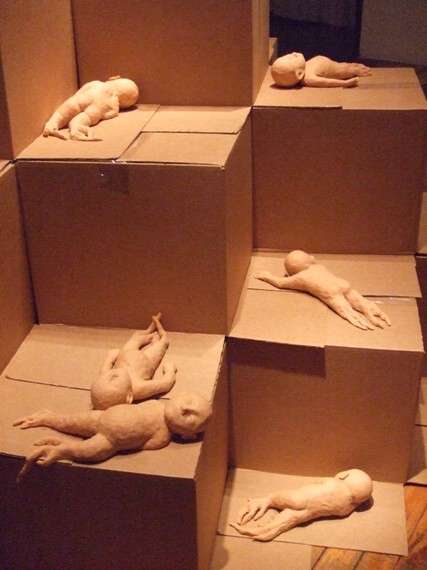
TS:
Vera, for this installation, you have sculpted with the medium
Plastilina, which is very evocative of human flesh in color
and consistency. Can you tell us about the qualities of Plastilina
that appeal to your sensibilities and what it contributes to
the overall aesthetic of the installation?
GVH:
Plastilina is a frail material, like the body. It is also a
direct medium. The artist’s fingerprints are still present
in the sculptures and thus help to create a feeling of flesh.
This frailness and directness gives the sculptures their aura
and therefore one can feel nearness in the installation.
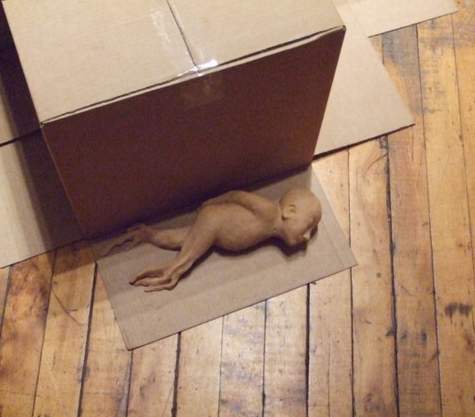 TS:
Plastilina is a pliable, impressionable and vulnerable substance;
you have used it to sculpt what you call the “root children,”
which are essentially limpid, unborn infants scattered like
debris, with gangly roots in lieu of feet, hovering between
death and an innocent child-like slumber.
TS:
Plastilina is a pliable, impressionable and vulnerable substance;
you have used it to sculpt what you call the “root children,”
which are essentially limpid, unborn infants scattered like
debris, with gangly roots in lieu of feet, hovering between
death and an innocent child-like slumber.
I’d
like to ask you about your choice to use the human baby as subject/object.
A human-like fleshy form is viscerally disconcerting. I confess
the first thought that came to my mind was abortion.
GVH:
The image of human infant is a metaphor for innocence, or something
that can not protect itself from abuse and violence. It is as
fragile as a flower.
The
first root children, I showed last year at the Broadway gallery,
in one pile had to do with the growing interest towards heavy
industry in Iceland that is causing much damage to natural wildlife.
The Icelandic government has recently been more concerned with
appeasing environmental polluters than with keeping sources
for plants and animals in tact; they are ready to destroy vast
lands to please the needs of companies like Alcoa and Alcan.
This piece, Happy Days, is a continuation of that theme, but
more focused on social developments and corporate takeover,
or when making money becomes more important than anything else.
Nothing stands in the way of the power of greed, even if it
may cost you your soul. These are times of Faust.
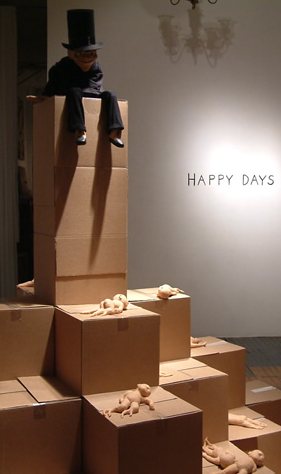 TS:
Happy Days certainly personifies that Faustian greed. In fact,
at the pinnacle, you have a Mephistopheles-like character, a
gremlin-ish puppet overseeing this mountain deceased fetuses.
You told me at the opening you borrowed the title “Happy
Days” from a Samuel Becket play. What about his play inspired
you to use it as the moniker for your installation?
TS:
Happy Days certainly personifies that Faustian greed. In fact,
at the pinnacle, you have a Mephistopheles-like character, a
gremlin-ish puppet overseeing this mountain deceased fetuses.
You told me at the opening you borrowed the title “Happy
Days” from a Samuel Becket play. What about his play inspired
you to use it as the moniker for your installation?
GVH:
Beckett has touched me because of his sharp vision on social
and human conditions.
In Beckett’s play a woman is sinking in garbage and shit.
She takes her antidepressant pills and smiles like nothing is
wrong. That is the image of the gremlin, or puppet, who sits
on the top of his hollow tower.
TS:
This hollow tower you mention is the pedestal, a staggered,
architectonic staircase constructed from overturned, cardboard
boxes. This seems particularly appropriate for the New York
City location. It reflects very poignantly the cityscape of
grid-like streets and gargantuan geometric structures whose
capitals recede into jagged spires. As a New Yorker myself,
I experience space in segments and compartments, going from
my closet sized apartment to a cramped subway to my office cubicle.
The boxes could also represent moving, being always on the move
or moving from home, “uprooting” like the “root
children”, and also homelessness, which we see so much
of on the streets of New York, bodies residing in boxes as makeshift
shelters. Would you talk about the box as a medium and how it
informs the piece as a whole?
GVH:
Like Plastilina the boxes are a fragile medium, especially stacked
up like that. They are also hollow and as material they fit
into the theme in some contrast with the Plastilina. The decision
to have cardboard boxes was explicitly for the New York show,
and as you described in your question, they have so much similitude
with New York City. It would, for instance not be as fitting
in Reykjavik.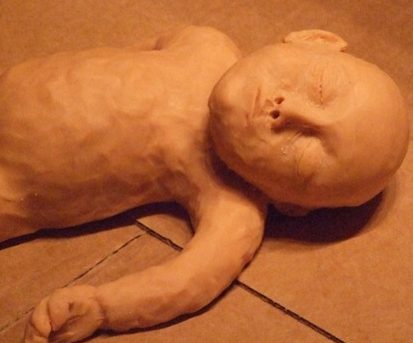
TS:
I want to come back to the villain at the apex of the pyramid
who hovers over his fetuses like a perverse, wide-eyed mad-man.
He is someone we instantly recognize as evil; allegorical and
uncannily perverse. His grin is contorted and the pupils of
his wide glassy eyes bulge out slightly asymmetrically and reflect
the crookedness of his character. Where did he come from in
your mind and how did he find his way into Happy Days?
GVH:
I did a show earlier in the year at Gallery Turpentine in Reykjavík
where I used a similar figure on top of a golden pyramid that
had a cape like an ancient king. That symbol of hierarchy was
not appropriate for New York, so I wanted a different kind of
symbol, a more “stock market” like figure. I was
quite inspired by the novel “Momo” by Michael Ende
that tells about the spiritless gray gentlemen that are so low
in outgoing energy that people felt cold around them. That image
felt more fitting as the culprit of the neglected and scattered
innocent root children.
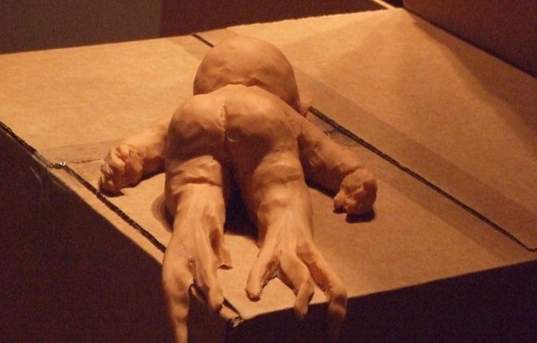 TS:
Yes, he represents the American king, the capitalist. Capitalism
is indiscriminate in its abuses of the planet until it impacts
the bottom line. So much wanton abuse of our innocent planet
(the root children) is done in the name of profit. We are desecrating
with greed what we require for our survival. “Happy Days”
accomplishes a dual and diametric representation of the evil
we do and that is being done presently in the world. It is a
statement that calls to us “children” to wake up,
take root, rise up and make a difference. Your work is a catalyst
for dialogue and action. If you could choose, what is the one
thing you would like each of us to take away from our visit
to “Happy Days?”
TS:
Yes, he represents the American king, the capitalist. Capitalism
is indiscriminate in its abuses of the planet until it impacts
the bottom line. So much wanton abuse of our innocent planet
(the root children) is done in the name of profit. We are desecrating
with greed what we require for our survival. “Happy Days”
accomplishes a dual and diametric representation of the evil
we do and that is being done presently in the world. It is a
statement that calls to us “children” to wake up,
take root, rise up and make a difference. Your work is a catalyst
for dialogue and action. If you could choose, what is the one
thing you would like each of us to take away from our visit
to “Happy Days?”
GVH:
Responsibility.

For more information go to www.this.is/veransu/vera